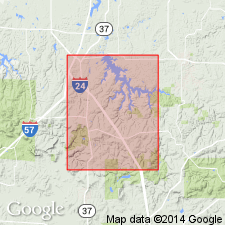
- Usage in publication:
-
- Bethlehem sandstone lentil
- Modifications:
-
- First used
- Dominant lithology:
-
- Sandstone
- AAPG geologic province:
-
- Illinois basin
Summary:
Several Pennsylvanian informal members and sandstone lentils are introduced in this report. Tradewater Formation in the Goreville quadrangle is subdivided into two informal mapping units, the lower Tradewater and the upper. The informal Bethlehem sandstone lentil occupies middle portion of the upper Tradewater and is the only unit in the upper Tradewater locally mappable. Unit is somewhat argillaceous and micaceous, contains abundant dark ferromagnesian grains, and can be described as a subgraywacke. Sandstone is typically reddish- to yellowish-orange, fine- to coarse-grained, and very friable. Thickness ranges from 10 to 30 feet. The top of the lower Tradewater is mapped as the top of the Murray Bluff Sandstone Member (a correlative of the Bernadotte Sandstone Member of Willman, 1975). The remainder of the lower Tradewater is subdivided into (ascending): Ferne Clyffe member, Cedar Creek sandstone lentil, and Lake of Egypt member (all informal). The Reynoldsburg Coal Bed is near the base of the Ferne Clyffe.
Source: GNU records (USGS DDS-6; Reston GNULEX).
For more information, please contact Nancy Stamm, Geologic Names Committee Secretary.
Asterisk (*) indicates published by U.S. Geological Survey authors.
"No current usage" (†) implies that a name has been abandoned or has fallen into disuse. Former usage and, if known, replacement name given in parentheses ( ).
Slash (/) indicates name conflicts with nomenclatural guidelines (CSN, 1933; ACSN, 1961, 1970; NACSN, 1983, 2005, 2021). May be explained within brackets ([ ]).

